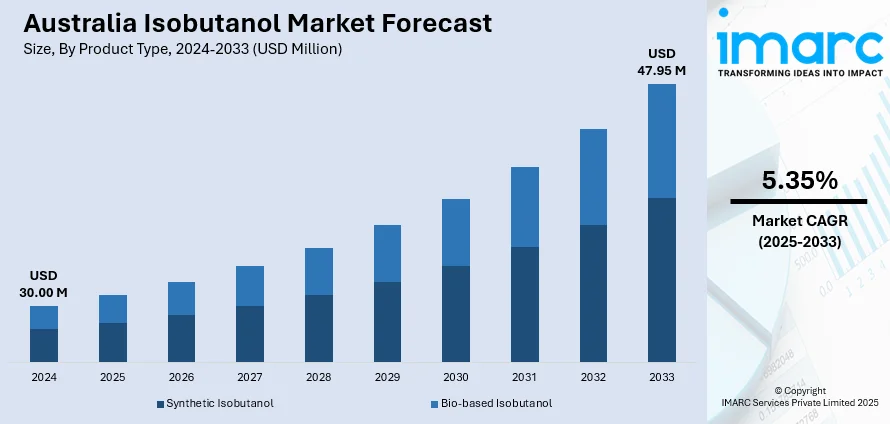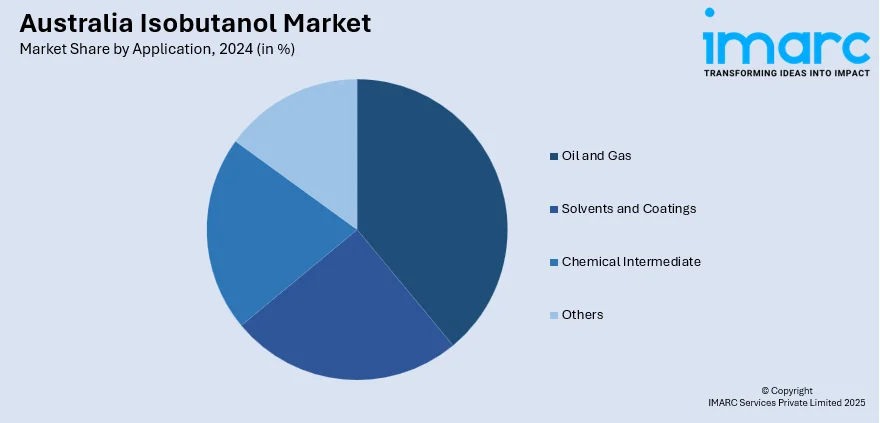
Australia Isobutanol Market Size, Share, Trends and Forecast by Product Type, Application, and Region, 2025-2033
Australia Isobutanol Market Overview:
The Australia isobutanol market size reached USD 30.00 Million in 2024. Looking forward, IMARC Group expects the market to reach USD 47.95 Million by 2033, exhibiting a growth rate (CAGR) of 5.35% during 2025-2033. Market growth is supported by increasing demand across the automotive, chemical, and coatings sectors. Furthermore, higher usage of bio-based isobutanol due to its green nature compared to conventional solvents, combined with an increase in industrial applications and government backing of sustainable solutions, is further fueling Australia isobutanol market share.
|
Report Attribute
|
Key Statistics
|
|---|---|
|
Base Year
|
2024 |
|
Forecast Years
|
2025-2033
|
|
Historical Years
|
2019-2024
|
| Market Size in 2024 | USD 30.00 Million |
| Market Forecast in 2033 | USD 47.95 Million |
| Market Growth Rate 2025-2033 | 5.35% |
Australia Isobutanol Market Trends:
Rising Demand from Automotive Sector
The automotive sector is one of the major driving forces behind the market for isobutanol in Australia. isobutanol is more and more employed as a solvent and intermediate during the manufacture of automotive coatings and paints. For instance, as per IMARC report, in 2024, the Australian market for automotive paints and coatings was valued at USD 5.2 Billion, with the automotive refinish coatings segment contributing USD 305.5 Million. These coatings need high-performance solvents to achieve stringent environmental and durability requirements. Due to the efforts of the automobile manufacturers to achieve better fuel efficiency and reduced emissions, the demand for high-quality coatings and paints, which are isobutanol-based, is increasing. Additionally, the transition towards electric vehicles (EVs) contributes to the increasing application of coatings for vehicle interior and exterior. While the Australian automotive industry continues to develop, demand for isobutanol will expand even further and propel market development in the future years.

To get more information on this market, Request Sample
Shift Toward Bio-based Isobutanol
There is increasing momentum in Australia towards bio-based isobutanol on account of environmental issues and regulatory pressures on conventional petroleum-based offerings. Bio-based isobutanol, derived from renewable materials such as corn and sugarcane, is viewed as a greener option compared to conventional isobutanol. As environmental legislation tightens, particularly in industries such as automotive and chemicals, the need for bio-based solvents and chemicals is likely to increase. Australian producers are now increasingly turning towards bio-based isobutanol as a move towards low carbon footprints and government-endorsed green technology policies. The transition is expected to significantly drive the Australia isobutanol market growth. For instance, in 2023, researchers at the University of Queensland (UQ) developed a method to accelerate the conversion of sugarcane into isobutanol, a key component in aviation fuel and other products. Collaborating with the Technical University of Munich, UQ focused on a specific enzyme to speed up the process. This cell-free approach offers higher yields and fewer side products compared to traditional cell-based methods. The research demonstrates the potential for sustainable biomanufacturing, with large-scale production now commercially viable, contributing to eco-friendly fuel and materials.
Australia Isobutanol Market Segmentation:
IMARC Group provides an analysis of the key trends in each segment of the market, along with forecasts at the region/country level for 2025-2033. Our report has categorized the market based on product type and application.
Product Type Insights:
- Synthetic Isobutanol
- Bio-based Isobutanol
The report has provided a detailed breakup and analysis of the market based on the product type. This includes synthetic isobutanol and bio-based isobutanol.
Application Insights:

- Oil and Gas
- Solvents and Coatings
- Chemical Intermediate
- Others
The report has provided a detailed breakup and analysis of the market based on the application. This includes oil and gas, solvents and coatings, chemical intermediate, and others.
Regional Insights:
- Australia Capital Territory & New South Wales
- Victoria & Tasmania
- Queensland
- Northern Territory & Southern Australia
- Western Australia
The report has also provided a comprehensive analysis of all the major regional markets, which include Australia Capital Territory & New South Wales, Victoria & Tasmania, Queensland, Northern Territory & Southern Australia, and Western Australia.
Competitive Landscape:
The market research report has also provided a comprehensive analysis of the competitive landscape. Competitive analysis such as market structure, key player positioning, top winning strategies, competitive dashboard, and company evaluation quadrant has been covered in the report. Also, detailed profiles of all major companies have been provided.
Australia Isobutanol Market Report Coverage:
| Report Features | Details |
|---|---|
| Base Year of the Analysis | 2024 |
| Historical Period | 2019-2024 |
| Forecast Period | 2025-2033 |
| Units | Million USD |
| Scope of the Report |
Exploration of Historical Trends and Market Outlook, Industry Catalysts and Challenges, Segment-Wise Historical and Future Market Assessment:
|
| Product Types Covered | Synthetic Isobutanol, Bio-Based Isobutanol |
| Applications Covered | Oil and Gas, Solvents and Coatings, Chemical Intermediate, Others |
| Regions Covered | Australia Capital Territory & New South Wales, Victoria & Tasmania, Queensland, Northern Territory & Southern Australia, Western Australia |
| Customization Scope | 10% Free Customization |
| Post-Sale Analyst Support | 10-12 Weeks |
| Delivery Format | PDF and Excel through Email (We can also provide the editable version of the report in PPT/Word format on special request) |
Key Questions Answered in This Report:
- How has the Australia isobutanol market performed so far and how will it perform in the coming years?
- What is the breakup of the Australia isobutanol market on the basis of product type?
- What is the breakup of the Australia isobutanol market on the basis of application?
- What is the breakup of the Australia isobutanol market on the basis of region?
- What are the various stages in the value chain of the Australia isobutanol market?
- What are the key driving factors and challenges in the Australia isobutanol market?
- What is the structure of the Australia isobutanol market and who are the key players?
- What is the degree of competition in the Australia isobutanol market?
Key Benefits for Stakeholders:
- IMARC’s industry report offers a comprehensive quantitative analysis of various market segments, historical and current market trends, market forecasts, and dynamics of the Australia isobutanol market from 2019-2033.
- The research report provides the latest information on the market drivers, challenges, and opportunities in the Australia isobutanol market.
- Porter's five forces analysis assist stakeholders in assessing the impact of new entrants, competitive rivalry, supplier power, buyer power, and the threat of substitution. It helps stakeholders to analyze the level of competition within the Australia isobutanol industry and its attractiveness.
- Competitive landscape allows stakeholders to understand their competitive environment and provides an insight into the current positions of key players in the market.
Need more help?
- Speak to our experienced analysts for insights on the current market scenarios.
- Include additional segments and countries to customize the report as per your requirement.
- Gain an unparalleled competitive advantage in your domain by understanding how to utilize the report and positively impacting your operations and revenue.
- For further assistance, please connect with our analysts.
 Request Customization
Request Customization
 Speak to an Analyst
Speak to an Analyst
 Request Brochure
Request Brochure
 Inquire Before Buying
Inquire Before Buying




.webp)




.webp)












